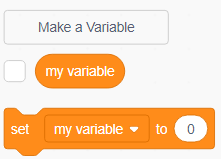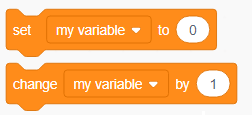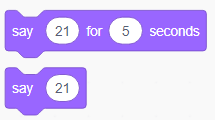Scratch and Python Basics
Learning a text-based language's syntax is difficult for many learners. Syntax mistakes occur when certain rules are violated in a program. Therefore, it's helpful to highlight the similarities and contrasts between two languages.
Below are some Scratch blocks and their Python equivalents. The list needs to be more thorough and is meant as a reference guide.
Basics of the scratch and python languages
Here we can see create, set, and display the basic variable values using the both programming language's syntaxes.
Variables in Scratch and Python
- In Python, a variable is formed when assigned a value, while in Scratch, it must be created first.
- Python requires single or double quotes around strings.


Boost increment a Variable
- Scratch lets you change a variable's value.
- Python lets you change a variable's value by assigning it to itself and adding or subtracting a number.


Python and Scratch output
- In Scratch, you make a sprite talk to output to the user.
- Python outputs to the shell with print statements.
- If you print strings in Python, use single or double quotes.
- The Python example above isn't the easiest. The while loop simplifies checking that the variable is smaller or equal to 10.


Comparison of the Scratch and Python language
The following points show similarities and differences between the Scratch and Python programming languages.
Python and Scratch infinite loops
- Scratch contains unlimited loops.
- Python uses an always-True conditional loop.
Selectivity (Conditional Selection)
- Two selection blocks are available in Scratch. Nested conditions are needed for many conditions.
- If, elif, and else are Python's selection statements. Again, colons and indentation are needed.
Testing Equality
- Scratch's equal sign (=) lets you compare values.
- Python's single equal sign is retained for variable assignment. Hence a double equal sign (==) is utilized to test for equality.
Lists in Scratch and Python
- Like variables, scratch lists are created.
- Lists in Python are created with square brackets ([]) and commas between items.
- You can use a list in python and scratch language.
- Both languages allow list removal. Scratch lists start at 1. Python lists start at 0. Python always counts from 0.
Randomness
- Scratch's random block generates numbers.
- Python needs random import to operate code.
- Both languages can pick random elements from a list.
Scratch and Python Concatenation
- Scratch's join block joins strings.
- Python uses the addition operation (+) to Join strings.
Indexing
- Both languages use item indexes to find items in lists and strings.
Input
- Scratch program asks block function to collect user input.
- Python uses the input() function for programming.
Python typecasting
- Scratch language recognizes strings and integers.
- Python language requires typecasting when converting. For example, you can convert strings to integers and vice versa.
Appeal and Complexity
- First things first: Python is more complicated than Scratch.
- Both Scratch and Python languages are wonderful for beginners (more on this later), but Python is text-based and better for secondary students.
Projects and applications
- Project-based learning is great for all ages; thus, both coding languages have potential.
- Scratch lets students make great art and games and enhance their learning with hardware. Beginners will appreciate creating a game sprite (character), and visual learners can integrate Scratch with VEX robotics.
- Python programming language's project potential is greater.
Project Length
- Python and Scratch require different amounts of labor to see results.
- Python can "slow burn." Python coding is great for analytical students who like logical problems and topic evolution. Start basic or with a hardware insert for visual or hands-on learners.
- Scratch accelerates payout! The language's bells and whistles keep kids interested and entertained.
Conclusion
Scratch and Python both are different programming languages to run development operations. Python and Scratch have many differences and also similarities in functionality.
|






 For Videos Join Our Youtube Channel: Join Now
For Videos Join Our Youtube Channel: Join Now










